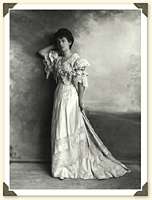
| Elsie Reford was born Elsie Stephen Meighen in Perth, Ontario on
22 January 1872. The eldest child of Robert Meighen and Elsie
Stephen, she was educated in Montreal after her parents moved
there in the early 1880's. She completed her studies in Dresden
and Paris where she perfected her knowledge of French and German On 12 June 1894 she married Robert Wilson Reford. They had two sons, Bruce and Eric. After establishing their first household in Montreal on Ontario Avenue (now Avenue du Musée), they built a house at 3610 Drummond Street in 1902 designed by Montreal architect Robert Findlay. The house was demolished by McGill University in 1968. She also ran a household at Beaurepaire, a summer house her husband had bought from his father in 1896. A talented musician, she played both the piano and the violin and practiced the violin daily until the First World War when her dedication to war work forced her to stop. Her brother, General Frank Meighen, was a musical impresario, founding the Montreal Opera and supporting the band of the Grenadier Guards of Montreal for many years. |
| Active in charitable activities, Elsie Reford was from 1900 to 1912 a director of the Montreal Maternity Hospital and was active in its organization and management. Dedicated to providing intellectual activities for women, she was active in the Women's Canadian Club and served as president of the club from 1911 to 1913. As the niece of Lord Mount Stephen and daughter of Robert Meighen, one of Montreal's most avowed imperialists, she was brought into contact with many leading Canadians and imperial figures, with whom she formed lifelong friendships. |  |
|
Her acquaintance with Lord Grey, the Governor-General of Canada from 1904 to 1911 led to her involvement in the organization of the Tercentenary Celebration of Quebec in 1908. She served as the President of the Montreal committee. This event was one of many in which she involved herself in an effort to build bridges with the French-Canadian community. She hosted events in her home where guests would range from Henri Bourassa to Lord Alfred Milner, Stephen Leacock to Arthur Meighen. Her friendship with Lord Grey led to her being the model for Louis-Philippe Hébert's monumental statue of Madeleine de Verchères, which was erected under Grey's patronage in Verchères in 1913. During the First World War she was engaged in war work on both
sides of the Atlantic, translating German documents for the War
Office and giving speeches while in Montreal. After the war, she
was active in the Victorian Order of Nurses, the Montreal Council
of Social Agencies and the National Association of Conservative
Women. |
      
|